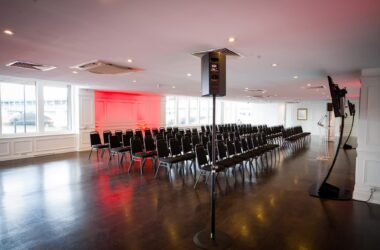How to run sustainable events
Sustainable Events and how they can help reduce Climate Change

For nearly three decades the UN has been bringing together almost every country on earth for global climate summits – these are called COPs. In that time climate change has gone from being a fringe issue to a global priority.
This year will be the 26th annual summit – giving it the name COP26. With the UK as President, COP26 takes place in Glasgow from 31st October to 12th November.
Back in 2015 at COP21 in Paris, every country agreed to work together to limit global warming to well below 2 degrees. Sadly, to date these commitments have not been met. Whilst global warming is one of the most critical issues of our modern-day world and requires that every country commits, we as individuals should also be trying to do our bit.
Reaching across every major industry across the world, sustainability has proved to be a key driver of growth and targeted development across sectors. This is now beginning to find a niche in the events industry as well, and the latest innovations in the sector point towards this very paradigm shift.
A sustainable event can be understood as one that takes into account its impact on the environment with respect to resource consumption, waste generation and pollutant emissions, among other factors, followed by minimizing these impacts to the lowest possible levels. The idea is to strengthen the community, where the event takes place, socially and economically.
One way of gauging the sustainability of an event is by measuring the impact the event has on the environment and the local community through quantifiable parameters. With climate change having taken centre stage globally, the resources we are consuming and the waste we are producing will have a clear and resounding impact. No wonder various stakeholders of all levels are looking for ways to introduce sustainability in the organisation of conferences, trade fairs, seminars and other events. In this article, we have compiled a set of tips and hacks for making events sustainable.

Keeping it Local
Without a doubt, transportation can prove to be one of the most difficult components of event organization, especially when it comes to environmental impact. The farther the resources, the greater the demand for transportation and logistics, which leads to higher pollutant emissions, greater costs and more human resource requirements.
Even if the distances are not too long, there is always going to be the factor of additional carbon footprint. In fact, the shorter the distance, the more fuel would be required in various stages of travel, meaning that medium distances will be even more disastrous for resource supplies. This is where the importance of local resources steps in.
Choosing a local venue to host the event, with local attendees and speakers, means that you can eliminate the need for participants or organizers to travel. At the same time, local suppliers can be roped in for the event to refrain from unnecessary costs of vendors and materials.
Using Natural Daylight in Event Spaces
The lighting and ambience of a space can have a pronounced impact on the emotional and psychological response of its occupants. This holds especially true for events, where the visual and psychological components can guide user behaviour and response throughout.
Natural lighting, in this case, offers not just a promising sustainable approach, but also an energizing and engaging influence on event participants.
In fact, poor lighting can have a negative effect on the event experience. While many event venues offer artificial lighting in all spaces, it is always better to use as much daylight as possible.
For instance, you cannot expect auditorium interiors to be daylit, considering the need for air conditioning, light control and dimming, and so on. However, auditorium foyers, lobbies, staircases and entrance/exit lobbies can be facilitated with natural lighting to make these spaces livelier and much more environment-friendly.

Organized Waste Management Plan
As we advance towards universal sustainable development goals, it becomes extremely important to make wiser choices of materials and products that do not produce as much waste. On average, a single guest could be behind 1.89 kg of waste per day in an event. Therefore, an efficient waste management plan must be put into place when planning events so that you already have an idea about the estimated quantity of waste that could be produced, the channels for managing, safely discarding or even recycling/upcycling waste.
Consolidated Transportation Services
In case you cannot keep the event localized in terms of venue or participants, to-and-fro transportation management can become a bottleneck for both the smooth functioning and sustainability of the event. The more vehicles that run, the more is the compounded negative drawdown on the environment, the greater the economic implications, and the more unsustainable the management becomes.
Consolidated transportation services offer a robust solution to this problem. Offering lower emission routes, these services include carpooling, biking or using public transportation for taking attendees to or from the event. The practice is based on a strong sustainable event management philosophy that places the environment over and above short-lived luxuries, even making the experience fun for attendees sharing common transportation services.
To encourage and implement such practices, however, event itineraries, travel routes, schedules and line-ups as well as monitoring of the service have to be managed effectively.
Spoiler: A Totally Sustainable Event Does Not Exist, But You Can Try
Sustainability can be made a priority, a practice and a philosophy, though you may not be able to achieve it entirely. In short, there is always room for improvement. The catch, however, is to be proactive right from the early stages of planning and get all stakeholders on board with your sustainability goals for the event.
Right from the materials and products you use in the event to the venue, several factors contribute to the success and ultimate outcome of your event’s eco-friendly initiatives. Going digital, however, is key to sustainability measures today, eliminating the need for paper and paper waste. The good news is that sustainability helps reduce costs instead of spiking them up, as is the general perception around the buzzword. Therefore, if you are looking for a cost-effective, low environmental impact way to go forth with your event, you can keep the above tips handy.
Related Posts
10 Common Mistakes to Avoid when Booking a Conference Venue
Booking a conference venue is a crucial step in planning a successful business event. However, many organisers make common mistakes that can lead to logistical problems, increased costs, or a…

Financial District’s Finest: Summer Party Venues for City Firms
Planning a summer party for your City firm? It can feel like a real challenge. You’ve got to stick to a budget, impress the bosses, and sort out all the…

Unique Opportunity to Host Pitch Events at Chelsea FC
Love sport and looking for a truly unique corporate away day? Experience the thrill of hosting Pitch Events at Chelsea FC With late some late availability due to changing match…

The Future of Event Venues: Trends to Watch in 2025
The events industry is constantly evolving, with technological advancements, sustainability initiatives, and changing attendee expectations shaping the future of event venues. As we move deeper into 2025, venues are finding…

